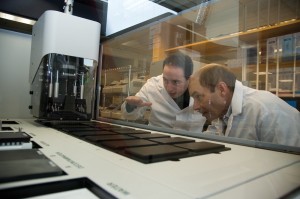
Kunkel (right) with DNA sequencing technologist Hal Schneider look on as a robot prepares sequencing reactions.
In the March/April Harvard Magazine, an in-depth profile recaps Louis Kunkel‘s long career as a gene hunter. In 1986, Kunkel’s identification of the gene responsible for Duchenne muscular dystrophy (DMD) was widely considered a milestone in genetics, and helped crystallize the idea of a Human Genome Project.
Today, nearly 30 years later, as director of the Genomics Program at Children’s Hospital Boston, Kunkel is still in touch with patients and families he met long ago. And while he never expected it to take so long for therapies to emerge for DMD, he’s still trying to find a cure — aided by new tools like the DNA sequencing machine.
Kunkel and Isaac Kohane, director of the Children’s Hospital Informatics Program, have forged a “New Deal” between genetic researchers and the patients who provide samples — known as the Gene Partnership Project. Unlike the situation in most research studies, participants (more than 650 to date) can control how their personal data is used, retrieve it if they want to, and receive genetic counseling.
There’s been a lot of recent skepticism about the medical usefulness of readouts from people’s genomes. But Kunkel and Kohane are undeterred. Working in their favor is a recent trend toward so-called “genetic stratification,” which, rather than seeking blockbuster drugs, uses genetic testing to tailor drugs to appropriate subgroups in whom they’re most likely to work. This trend is especially evident in cancer and in rare diseases. Genomic medicine isn’t dead yet.






